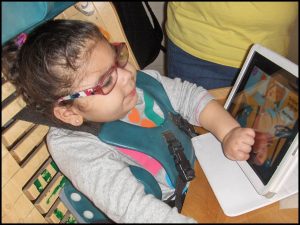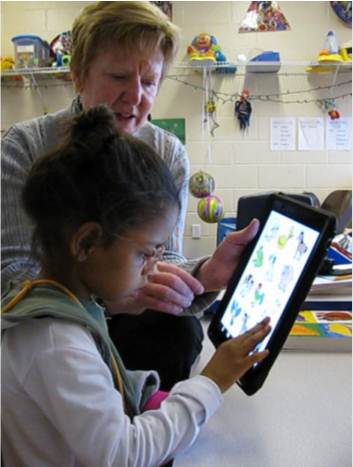Part Two of Cooney Center Fellow Sarah Vaala’s day spent observing children with developmental disabilities and iPads. Part One focused on the affordances of the iPad. Part Two focuses on specific skills that are fostered through using an iPad. Part Three addresses the limitations.
 During my day at the Mary Cariola Children’s Center Preschool Program I saw firsthand how teachers and specialists there use iPads and associated apps to help young students with developmental disabilities foster specific skills. In fact, if you can find the skill in a child’s individual education plan, chances are the dedicated staff has found a way to target it with interactive technology! I was particularly struck by the ways the iPad can motivate and assist these special learners in boosting the ability to understand cause and effect, use language, and interact socially.
During my day at the Mary Cariola Children’s Center Preschool Program I saw firsthand how teachers and specialists there use iPads and associated apps to help young students with developmental disabilities foster specific skills. In fact, if you can find the skill in a child’s individual education plan, chances are the dedicated staff has found a way to target it with interactive technology! I was particularly struck by the ways the iPad can motivate and assist these special learners in boosting the ability to understand cause and effect, use language, and interact socially.
Interacting with iPad apps is a great way of demonstrating direct cause and effect. When a student touches the screen, he or she can watch an animal move, see the page turn, or hear a guitar play. Those reactions invite the student to touch the screen again. The cycle results in children’s awareness of their own control over the activity and, ultimately, their exploration and self-directed learning. Responses from the iPad may be particularly powerful experiences for children with limited fine motor skills. While the demands of clicking a mouse or holding a pencil preclude some children at Mary Cariola from interacting with other media, the iPad can respond to even gross movements. A swipe – any swipe – on the screen can have a direct and rewarding effect on the visual and auditory content conveyed. The teachers at Mary Cariola also noted that several students have been more motivated to work on developing their fine motor skills so that they can do more with the iPad and its apps.
Blessed works with teacher Dana on numbers.
Content delivered via the iPad can help children with cognitive delays develop their capacity to communicate with those around them. While some children at Mary Cariola may not have the ability to ever produce language – verbal or sign – various activities on the iPad can help them develop their receptive language skills (or ability to understand language). For example, the ability to understand picture symbols enables a child with cognitive disabilities to generalize her understanding of familiar objects through different levels of representation including photographs, drawings, and sounds. Furthermore, understanding language helps children to make sense of events around them, predict what’s coming next, and to feel a sense of control and security. Many iPad apps include extensive picture libraries of objects and actions, the meaning of which can be illuminated through visual or auditory information (for example, a dog barks when you touch the icon) or through the incorporation of toys and props by teachers. The ability to understand picture symbols can help a child with cognitive disabilities to communicate her wants and needs to others – that is, use expressive language – by pointing or gesturing towards specific symbols.
Gracie and Joan used the iPad to learn about animals and the sounds they make.
Using the iPad can also motivate children who are capable of vocalizing and producing speech but do not do so readily. I watched speech therapist Emily Hanagan as she used several different apps on the iPad with 4-year-old Markus—a student with the capacity for verbal communication despite his reluctance and difficulty with speech production. Emily would take the iPad from Markus to bring up a new app and prompt him to say “I want more.” After a few minutes of this modeling, Markus was verbally requesting “more” iPad activities completely unprompted, a behavior which he has subsequently begun using in other contexts to express his wants and needs. “Sometimes he’ll say the whole phrase,” explained a beaming Emily, “but he learned it with [the iPad] and now uses it throughout the day – like during snack.”

Apps which record a user’s voice are particular favorites among the preschool students at Mary Cariola. In an especially touching moment during my time at Mary Cariola, I joined Dana and two of her students as they used the “Talking Carl” app. Both children have physical conditions which make the production of speech more difficult, and as a result they use some signs but do not vocalize. That is, they do not vocalize unless “Talking Carl” is around… I was astounded to see the two children, who had been engaged but silent the rest of the day, delight in yelling as loud as they could at Carl. Their joyfulness grew as Carl – a little red character with a very big mouth – jumped around and repeated their vocalizations right back. Pictured below is one of the students, Nasir, creating his very own monster with the Elmo’s Monster Maker app.

Using the iPad with peers and teachers helps young students with developmental disabilities to learn social skills. Dana and Colleen emphasized that they use the iPad to work towards many different goals within students’ individual education plans, including social skill development. For some students at Mary Cariola increasing awareness of peers is an important goal. Passing the iPad to the next student can help teach this awareness, as well as turn-taking skills, peer-to-peer imitation, interaction, and collaborative play. When Dana first introduced the iPad to the students in her classroom she watched in amazement as Nasir (pictured above) took his classmate’s hand and gently brought it up to touch the iPad screen. Not just a tender moment, this behavior represented a substantial milestone in Nasir’s social skill development.
Perhaps the most powerful characteristic of the iPad as a learning tool is its power to motivate and engage students. Underlying each area of skill development is the sheer magnetism between child and iPad. In fact, the unrivaled appeal of the iPad among students was not only mentioned by each teacher that I spoke with at Mary Cariola, but was also apparent in my observations of the students as they interacted with the devices. “The technology is so captivating, familiar, and engaging,” said Dana, “that the students can make progress much faster.”
In Colleen Adam’s classroom, I was astounded at the sight of eight preschoolers seated quietly, listening intently to the Sesame Street Playground book on the iPad, and then was even more impressed as they each patiently watched and waited as classmates took their turns making monsters with “Elmo’s Monster Maker.” (Attention Sesame Workshop designers – you should see these impressive monsters!) According to Colleen, “sometimes when I’m giving them a direction, like to split into two groups, I will have to tell them three times. But when it’s iPad time…they’ll get right over there and get in their chairs and they’re like ‘alright! I’m ready!’”
It is impossible to spend a day at Mary Cariola and not be inspired by the staff and students and the spirit of innovation and learning present there. The teachers and other staff work diligently to incorporate iPads within students’ education plans in a thoughtful way, constantly working to find quality apps and figure out how to best employ them. The students are so eager to learn and to use the iPad as a means for making their personalities and abilities known to the adults in their lives. Both parties seem proud and invigorated by each new accomplishment demonstrated by a student – however small an accomplishment might appear to an outside observer.
Still, the teachers and other staff at Mary Cariola did point out some of the limitations of using the iPad with their students; a topic which I will address in Part Three!



